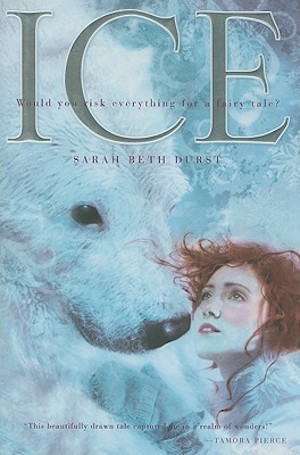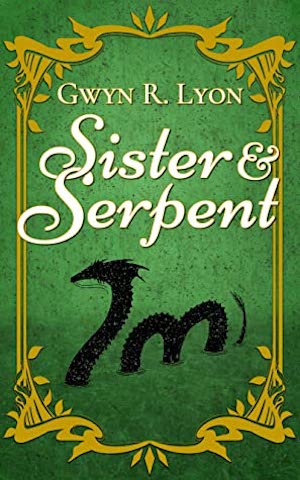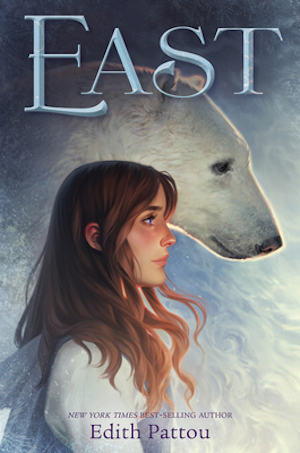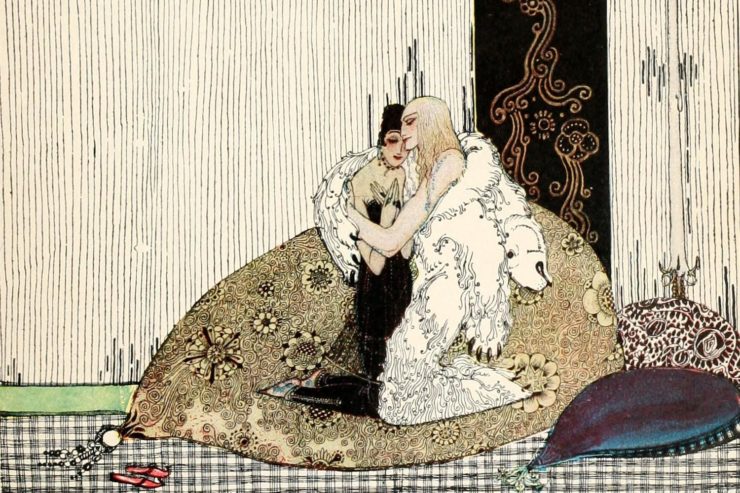I have always loved the fairy tale “East of the Sun, West of the Moon” (and I admit I feel even more connected to it since moving to high latitude a couple of years ago). A perfect tale for the cold and snowy season, this Norse fairy tale answers the question of what comes after the happy ending, after true love has been declared.
If you aren’t familiar, the premise is quite similar to that of “Beauty and the Beast”—though usually the poor father in this tale is not (always) at fault for handing off his youngest daughter over an unfortunate horticultural theft. The “beast” in this tale (usually a white bear or other white wild creature) comes to the family home and asks respectfully to join in the evening meal. Afterwards, he promises riches and comfort to the family if one of the daughters will return to his own home with him. The youngest (or eldest) agrees, and away they go to an enchanted palace where the heroine has everything she needs, and eventually falls in love with the sweet nature of her beastly suitor, who spends every night in her room with all the lights extinguished, and extracts the heroine’s promise that she will never seek to see him at night.
Of course, she does (and those familiar with the tale of Cupid and Psyche will recognize the echo here). Instead of a beast, she finds a handsome prince, and it seems for a moment that her heart has guided her correctly, and her husband is not only kind and gentle but also handsome and strong. Only…he’s under a curse, and now that she’s seen his human form, he’s whisked away from her to the home of the troll queen, and only at this point does the story truly begin.
Buy the Book


Over the Woodward Wall
The heroine undertakes a quest to the ends of the earth, asking the wind for guidance (and only the North wind can take her to the place that is East of the Sun and West of the Moon), to find her true love. Once there, she not only has to trick the troll queen, but must also awaken her true love’s memory of her and bring him out of the enchantment that clouds his mind. Different versions give the heroine varying amounts of aid, from cracking open magical walnuts filled with enticements for the troll queen to the simple coincidence of a fellow captive overhearing the heroine pleading with her true love to wake and see her.
Fairy tales are often (rightly, in some cases) criticized for featuring passive heroines who simply await rescue. “East of the Sun, West of the Moon” gives us the opposite: here is a woman who has to rescue her prince, with nothing but her wits and her courage.
Sun and Moon, Ice and Snow by Jessica Day George

The heroine of this tale has no name—her mother is so tired of having children that she doesn’t bother. So, clearly, a large family. When the lass, who grows up mostly left to her own devices, saves a lucky white reindeer, she is gifted with both a name and the ability to speak to animals. Naturally, this comes in handy when a white bear appears at the family home, and from there the familiar story falls into place neatly and sweetly. The heroine’s boundless curiosity makes her both relatable and believable, in spite of the strange circumstances she finds herself a part of.
Ice by Sarah Beth Durst

Grounded in modern reality, this variation features Cassie, and starts with her accompanying her father at an arctic research station near the north pole. She’s grown up listening to her father’s fairy tale of how her mother was the daughter of the north wind, and how when she fell in love, the Polar Bear King tried to hide her from the north wind—unsuccessfully, which is why Cassie’s mother is gone. Of course, Cassie knows this is just a story. Except…one day Cassie meets an enormous polar bear, and suddenly her scientific reasoning and her understanding of the world will be put to the test. With “trolls” who are more ambiguous than bad, and a motivation that isn’t based on romance, this is a delightful retelling that adds nuance and depth to the original story.
Sister & Serpent by Gwyn R. Lyon

Technically based on an even more obscure variation of the tale—“The Green Serpent,” as told by Madame d’Aulnoy—the story will still feel familiar to anyone who knows the Norse fairy tale. Twin sisters Rosalinda and Sophia are polar opposites: Rosalinda beautiful but stupid, Sophia clever but ugly. When Rosalinda is granted a gift of great intellect, Sophia runs away in despair and is drawn to an enchanted castle, where she finds herself speaking to a mysterious suitor by dark of night. When she tries to learn who he is, he’s whisked away, and the familiar pattern begins. This one also draws on a Charles Perrault tale, “Ricky of the Tuft,” and offers a satisfying variation in that the princess embraces her self-worth without magically becoming beautiful.
East by Edith Pattou

Rose is the heroine in this version, and is struck with wanderlust while the rest of her family are comfortable and happy in the little village they have always known. When her sister falls ill, and the mystical white bear appears to offer a healing gift in exchange for Rose’s company, she can’t refuse the bargain. Rose’s determination and curiosity are well established from the beginning of her story, so it’s easy to follow along as she wins her way through to saving her love and securing her happiness.
Echo North by Joanna Ruth Meyer

This version spends the major portion of its narrative on the protagonist’s agreed-upon year in exile, building a magical world for its heroine, Echo, to explore. She agrees to go with a mysterious white wolf in exchange for her father’s rescue from a snowstorm, and finds herself in a strange house full of changing rooms and a truly remarkable library of mirror books, which allow an even-more-than-usual total immersion in their stories. Within the books, she meets two other readers, another young woman named Mokosh and a young man named Hal. Echo gets to know them as she grows to understand the enchanted house and its inhabitant, the terse, enchanted creature she knows only as “Wolf.” The ending dovetails nicely with a bit of Scottish folklore, and this retelling explores second chances even more deeply than most.
***
“East of the Sun, West of the Moon,” in all its variations, is a welcome reminder that recognizing a true love isn’t enough; there are times when more is needed, whether that’s understanding and communication, or going the extra mile, or realizing that there’s more to this person and no relationship is perfect or always easy. It’s one of my favorite tales precisely because the trials don’t end when the characters recognize their love for each other. That is just the beginning of the journey.
What are your favorite versions?
Rachel Ayers lives in Alaska, where she writes cabaret shows, daydreams, and looks at mountains a lot. She has a degree in Library and Information Science which comes in handy at odd hours, and she shares speculative poetry and flash fiction (and cat pictures) at patreon.com/richlayers.










